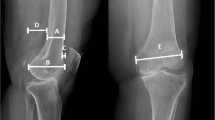Abstract
Background: The correct sizing of the components in both anteroposterior and mediolateral (ML) dimensions is crucial for the success of a total knee arthroplasty (TKA). The size of the implants selected is based on the intraoperative measurements. The currently used TKA implants available to us are based on morphometric measurements obtained from a Western/Caucasian population. Hence, the risk of component ML mismatch is more common in Asian sub-population, as they are of a smaller built and stature. This study aims to look into the following aspects - magnitude of the ML mismatch between the femoral component and the patient’s anatomical dimension, evaluation of gender variations in distal femur dimensions, and gender-wise and implant-wise correlation of ML mismatch.
Materials and Methods: Intraoperatively, the distal femoral dimensions were measured using sterile calipers after removing the osteophytes and compared with the ML dimension of the implant used. ML mismatch length thus obtained is correlated with the various parameters.
Results: Males showed larger distal femoral dimensions when compared to females. Males had larger ML mismatch. None of the implants used perfectly matched the patient’s anatomical dimensions. Patients with larger mismatch had lower scorings at 2 years postoperative followup.
Conclusion: Implant manufacturers need to design more options of femoral implants for a better fit in our subset of patients. The exact magnitude of mismatch which can cause functional implications need to be made out. The mismatch being one of the important factors for the success of the surgery, we should focus more on this aspect.
Similar content being viewed by others
References
Shah DS, Ghyar R, Ravi B, Hegde C, Shetty V. Morphological measurements of knee joints in Indian population: Comparison to current knee prostheses. Open J Rheumatol Autoimmune Dis 2014;4:75–85.
Vaidya SV, Ranawat CS, Aroojis A, Laud NS. Anthropometric measurements to design total knee prostheses for the Indian population. J Arthroplasty 2000; 15:79–85.
Chaichankul C, Tanavalee A, Itiravivong P. Anthropometric measurements of knee joints in Thai population: Correlation to the sizing of current knee prostheses. Knee 2011;18:5–10.
Chin KR, Dalury DF, Zurakowski D, Scott RD. Intraoperative measurements of male and female distal femurs during primary total knee arthroplasty. J Knee Surg 2002;15:213–7.
Chin PL, Tey TT, Ibrahim MY, Chia SL, Yeo SJ, Lo NN. Intraoperative morphometric study of gender differences in Asian femurs. J Arthroplasty 2011;26:984–8.
Celik T, Yuksel D, Kosker M, Kasim R, Simsek S. Vascularization of coralline versus synthetic hydroxyapatite orbital implants assessed by gadolinium enhanced magnetic resonance imaging. Curr Eye Res 2015;40:346–53.
Ewe TW, Ang HL, Chee EK, Ng WM. An analysis of the relationship between the morphometry of the distal femur, and total knee arthroplasty implant design. Malays Orthop J 2009;3:24–8.
Kwak DS, Han S, Han CW, Han SH. Resected femoral anthropometry for design of the femoral component of the total knee prosthesis in a Korean population. Anat Cell Biol 2010;43:252–9.
Ha CW, Na SE. The correctness of fit of current total knee prostheses compared with intra-operative anthropometric measurements in Korean knees. J Bone Joint Surg Br 2012;94:638–41.
Rosenstein AD, Veazey B, Shephard D, Xu KT. Gender differences in the distal femur dimensions and variation patterns in relation to TKA component sizing. Orthopedics 2008;31:652.
Guy SP, Farndon MA, Sidhom S, Al-Lami M, Bennett C, London NJ. Gender differences in distal femoral morphology and the role of gender specific implants in total knee replacement: A prospective clinical study. Knee 2012;19:28–31.
Vundelinckx BJ, Bruckers L, De Mulder K, De Schepper J, Van Esbroeck G. Functional and radiographic short-term outcome evaluation of the Visionaire system, a patient-matched instrumentation system for total knee arthroplasty. J Arthroplasty 2013;28:964–70.
Ho WP, Cheng CK, Liau JJ. Morphometrical measurements of resected surface of femurs in Chinese knees: Correlation to the sizing of current femoral implants. Knee 2006;13:12–4.
Hitt K, Shurman JR 2nd, Greene K, McCarthy J, Moskal J, Hoeman T, et al. Anthropometric measurements of the human knee: Correlation to the sizing of current knee arthroplasty systems. J Bone Joint Surg Am 2003;85-A Suppl 4:115–22.
Davis JJ, Bono JV, Lindeque BG. Surgical strategies to achieve a custom-fit TKA with standard implanttechnique. Orthopedics 2010;33:569–76.
Maniar RN, Singhi T. Patient specific implants: Scope for the future. Curr Rev Musculoskelet Med 2014;7:125–30.
Lonner JH, Jasko JG, Thomas BS. Anthropomorphic differences between the distal femora of men and women. Clin Orthop Relat Res 2008;466:2724–9.
Tait R. Redefining Joint Replacement; Today’s Medical Developments; 5 August, 2013.
O’Connor MI. Implant survival, knee function, and pain relief after TKA: Are there differences between men and women? Clin Orthop Relat Res 2011;469:1846–51.
Siow WM, Chin PL, Chia SL, Lo NN, Yeo SJ. Comparative demographics, ROM, and function after TKA in Chinese, Malays, and Indians. Clin Orthop Relat Res 2013;471:1451–7.
Author information
Authors and Affiliations
Corresponding author
Additional information
This is an open access article distributed under the terms of the Creative Commons Attribution-NonCommercial-ShareAlike 3.0 License, which allows others to remix, tweak, and build upon the work non-commercially, as long as the author is credited and the new creations are licensed under the identical terms.
Rights and permissions
About this article
Cite this article
Thilak, J., George, M.J. Patient - implant dimension mismatch in total knee arthroplasty: Is it worth worrying? An Indian scenario. IJOO 50, 512–517 (2016). https://doi.org/10.4103/0019-5413.189618
Published:
Issue Date:
DOI: https://doi.org/10.4103/0019-5413.189618
Key words
- Distal femoral dimensions
- femoral component
- gender specific knee
- mediolateral mismatch
- total knee arthroplasty




